Influence of the degree of substitution on the absorptivity of acidic carboxymethyl cellulose in the form of nonwoven fabric
Authors:
Ruta Masteiková; Lenka Vinklárková; Jan Muselík; David Vetchý; Jurga Bernatoniene; Tomáš Sopuch
Authors‘ workplace:
Katedra technologie léků a sociální farmacie, Farmaceutická fakulta, Akademie medicíny, Litevská univerzita zdravotních věd, Litva
; Holzbecher spol. s r. o. barevna a bělidlo Zlíč, divize Holzbecher Medical
; Veterinární a farmaceutická univerzita Brno, Farmaceutická fakulta, Ústav technologie léků
Published in:
Čes. slov. Farm., 2013; 62, 89-94
Category:
Original Articles
Overview
Modern wound treatment is based on the creation of moist wound environment which accelerates healing. For these purposes some devices and materials may be used, including carboxymethyl cellulose (CMC). Wound dressings currently available on the market contain CMC in the form of sodium salt. CMC in the acidic form has not been used in wound healing therapy yet. Likewise, there are only a few papers describing the acidic CMC preparation and properties, which are inter alia dependent on the degree of substitution (DS). Therefore, the aim of the study was to evaluate the influence of DS on absorptivity, which is one of the main features of dressings after application on the wound. Samples with DS from 0.1 to 0.45 were examined using five media: purified water, normal saline, buffer solution with pH 7.4, physiological buffer solution with pH 7.2, and solution A. Absorptivity was evaluated using a model wound created by us. It has been found that from the viewpoint of absorptivity the optimal DS of acidic CMC in the form of nonwoven fabric lies in the range from 0.25 to 0.35. Below or above these values the absorptivity is worse.
Keywords:
moist wound healing – carboxymethyl cellulose – degree of substitution – absorptivity
Sources
1. Shai A., Maibach H. I. Wound Healing and Ulcers of the Skin. Berlin: Springer-Verlag 2005.
2. Boateng J. S., Matthews K. H., Stevens H. N. E., Eccleston G. M. Wound healing dressings and drug delivery systems: A review. J. Pharm. Sci. 2008; 97, 2892–2923.
3. World Union of Wound Healing Societies (WUWHS). Principles of best practice: Wound exudate and the role of dressings. A consensus document. London: MEP Ltd. 2007; 10 p.
4. Gottrup F., Apelqvist J., Price P. Outcomes in controlled and comparative studies on non-healing wounds: recommendations to improve the quality of evidence in wound management. EWMA document. J.Wound Care 2010; 19, 239–268.
5. Stryja J. Moderní postupy v léčbě nehojících se ran. Remedia 2010; 20, 180–184.
6. Timmons J. Skin function and wound healing physiology. Wound Essentials 2006; 1, 8–17.
7. Sweeney I. R., Miraftab M., Collyer G. A critical review of modern and emerging absorbent dressings used to treat exuding wounds. Int. Wound J. 2012; 9, 601–612.
8. Jeffcoate W. J., Price P. E., Phillips C. J., Game F. L., Mudge E., Davies S., Amery C. M., Edmonds M. E., Gibby O. M., Johnson A. B., Jones G. R., Masson E., Patmore J. E., Price D., Rayman G., Harding K. G. Randomised controlled trial of the use of three dressing preparations in the management of chronic ulceration of the foot in diabetes. Health Technol. Assess. 2009; 13 (54), 1–110.
9. Oudhoff K. A., Buijtenhuijs F. A., Wijnen P. H., Schoenmakers P. J., Kok W. T. Determination of the degree of substitution and its distribution of carboxymethylcelluloses by capillary zone electrophoresis. Carbohydr. Res. 2004; 339, 1917–1924.
10. Advanced Wound Care Product Summary. http://www.ccac-ont.ca/Upload/hnhb/General/AdvancedWoundCareProductsSummaryfinal.pdf (14. 2. 2013).
11. Parikh D. V., Fink T., DeLucca A. J., Parikh A. D. Absorption and swelling characteristics of silver (I) antimicrobial wound dressings. Textile Res. J. 2010; 81, 494–503.
12. Quin Y. The characterization of alginate wound dressings with different fiber and textile structures. J. Appl. Polym. Sci 2006; 100, 2516–2520.
13. Lutz J. B., Zehrer C. L., Solfest S. E., Walters S.-A. A new in vivo test method to compare wound dressing fluid handling characteristics and wear time. Ostomy Wound Manag. 2011; 57, 28–36.
14. Ramli N. A., Wong T. W. Sodium carboxymethylcellulose scaffolds and their physicochemical effects on partial thickness wound healing. Int. J. Pharm. 2011; 403, 73–82.
15. Sezer A. D., Hatipoğğlu F., Cevher E., Oğğurtan Z., Başş A. L., Akbuğğa J. Chitosan film containing fucoidan as a wound dressing for dermal burn healing: Preparation and in vitro/in vivo evaluation. AAPS PharmSciTech 2007; 8 (2) Article 39. http://www.aapspharmscitech.org.
16. Terrill P., Sussman G., Bailey M. Absorption of blood by moist wound healing dressings. Primary Intention 2003; 11, 7–17.
17. Foam Wound Dressing Testing – Fluid Handling Capacity. http://www.dressings.org/TechnicalPublications/PDF/S+N-Allevyn-March-2007/SMTL-report-2283-FHC.pdf (7. 2. 2013).
18. Trengove N. J., Langton S. R., Stacey M. C. Biochemical analysis of wound fluid from nonhealing and healing chronic leg ulcers. Wound Repair. Regen. 1996; 4, 234–239.
19. Podlaha J., Horáková M., Vytřasová J., Moťková P., Masteiková R., Vinklárková L., Sopuch T. Hcel HT – nový typ celulózového krytí na ošetřování ran. Hojení ran 2013; 7, 26.
20. Pushpamalar V., Langford S. J., Ahmad M., Hashim K., Lim Y. Y. Absorption characterization of Ca2+, Na+, and K+ on irradiation crosslinked carboxymethyl sago pulp hydrogel. J. Appl. Polym. Sci. 2013; 128, 1828–1833.
21. Pushpamalar V., Langford S. J., Ahmad M., Hashim K., Lim Y. Y. Preparation of carboxymethyl sago pulp hydrogel from sago waste by electron beam irradiation and swelling behavior in water and various pH media. J. Appl. Polym. Sci. 2013; 128, 451–459.
22. Touati G., Barry M., Cauet H., Biendo M., Strohl P. Antibacterial effect of modified cellulose: in vitro and clinical study potential applications in the prevention of surgical site infection. Hojení ran 2013; 25–26.
Labels
Pharmacy Clinical pharmacologyArticle was published in
Czech and Slovak Pharmacy

2013 Issue 2
Most read in this issue
- Evaluation of the influence of sterilization method on the stability of carboxymethyl cellulose wound dressing
- Prolegomenon of the Czech pharmacognosy: 21st century
-
Physiological aspects of lipoxygenase in plant signaling systems
Part I. Octadecanoid pathway - Influence of the degree of substitution on the absorptivity of acidic carboxymethyl cellulose in the form of nonwoven fabric
